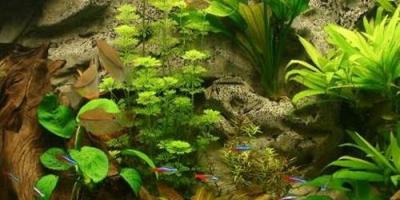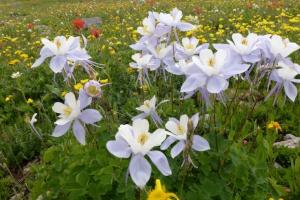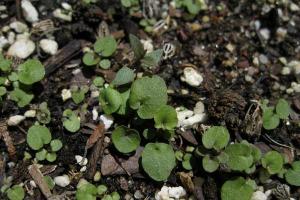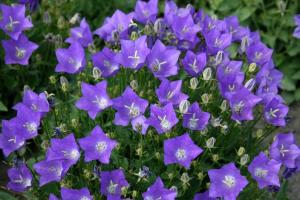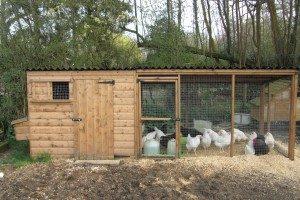The name “bell” (Campanula) unites a huge group of herbaceous plants of the Campanulaceae family, which includes more than 350 species, and most of them are often found in Russia. The culture can grow in forest and mountainous areas, on the banks of reservoirs and in the steppe. It is distributed throughout the European part of the continent, and flowers similar to bells can also be found in North America.
Garden and indoor flowers that look like bells can be biennial or perennial, depending on the species. Representatives of this group differ in stem height, petal shade and inflorescence diameter. Below are photos and names of the most common plants with characteristic bell-shaped flowers.
These perennial plants from the Campanaceae family are often called “big bells” because of their large flowers.
The culture can be recognized by whorled leaves of elliptical, lanceolate or oblong shape. The stems of adenophora are thick and the roots are radish-like. The inflorescences are paniculate or racemose, the petals are purple or blue.
In nature, there are about 6 dozen varieties of adenophora, most of which are excellent honey plants. They can grow in any soil and multiply quickly. The flowering period of this crop occurs in mid-July.

This herbaceous perennial has an impressive branched rhizome, making it difficult to transplant. Aquilegia stems reach a height of 50 to 80 cm, and at the base of the culture there is a dense rosette of dark green leaves with a waxy coating. Their length reaches 5 cm, and width - 2-3 cm.
The buds on this crop appear early and bloom in early June. It is noteworthy that each flower lives for about 6-8 days, then it fades and is replaced by another.
Depending on the variety, the color of the petals can be white, yellow, pink, purple, crimson, blue and dark purple. At the end of the flowering period, fruits with small black seeds are formed on the aquilegia. When properly stored, planting material remains viable for 1-2 years.
Attention! The seeds of this crop are extremely poisonous, so personal precautions should be taken when working with them.

This plant is often called "angel's trumpets". This is due to the fact that it grows incredibly quickly, and the flowers of this crop can increase by 3-4 cm in 24 hours, and if the growing conditions are more than favorable, then even by 6-7 cm.
Brugmansia is a large and lushly flowering tree-like shrub that reaches 5 m in height. Its flowers are incredibly attractive. These are huge bells, up to 20 cm in diameter and up to 50 cm in length.
The buds of the culture have a persistent characteristic aroma, which is especially intensified at night. The color of the petals can be pink, orange, peach, yellow, cream and even greenish.

Galanthus or snowdrop is a bulbous perennial from the Amaryllis family. The plant is distributed in Europe, Moldova, Ukraine, Georgia, Asia Minor, Azerbaijan and the North Caucasus. In the wild, galanthus grow on forest edges, meadows and along river banks.
This crop with grayish-green leaves reaches a height of up to 10 cm, and fragile white flowers appear very early, in late February or early March.
At the end of the flowering period, a fruit is formed on the bush in the form of a large fleshy capsule, which contains spherical seeds.
For your information. In many areas, galanthus are on the verge of extinction and are listed in the Red Book of Russia.

Hyacinthoides are bulbous perennials that belong to early flowering plants. There are other names: “Spanish scilla”, “Spanish endymion”, “Spanish scilla” and “wild hyacinth”.
This is an unpretentious crop that can often be found in flower beds and garden plots. The plant has basal leaves 20-30 cm long and a single peduncle reaching a height of up to 30 cm.
Hyacinth may have lilac, white, pink, blue or blue bell-shaped flowers 1.5-2 cm in diameter. The crop blooms at the end of May or beginning of June, and this period lasts up to 20 days.

This name unites approximately 400 varieties of annual and perennial herbaceous plants. They are distributed on all continents of the planet, with the exception of Africa and Antarctica.
Gentian has strong stems, basal leaves collected in a rosette and a few single flowers. The length of the plant, depending on the variety, can reach from 20 to 150 cm.
The color of the petals is blue, blue, yellow or white. The flowering period occurs at different times, for some species it is spring, for others it is summer or autumn. When the flowers dry out and fall off, the fruit appears in the form of a single-cavity capsule, inside of which there are small seeds.

This plant from the nightshade family is considered very poisonous and has other names: “crazy grass”, “moon flower”, “drunk cucumber” and “henbane”. Sometimes people call it “datura grass.”
The height of this crop can reach 150 cm. Datura has a thick stem, huge leaves and a long white taproot.
The flowers of the plant are large and very fragrant. The color of the petals is most often white, but you can also find purple flowers that resemble a lily in shape.
The plant blooms in July, and this period lasts until the end of September. As a rule, Datura buds bloom only in the evening, and when they fade, a fruit is formed, which is a box of 4 sections, covered with small spines. It can contain up to 800 grains.

This heat-loving plant, originally from the tropics, has 9 varieties. However, among flower growers, only one subspecies is most popular, which is called “creeping kobeya” or “monastery bells”.
The culture is characterized by long stems, their dimensions reach 7 meters. They contain feathery leaves, and the tops of the branches are crowned with tenacious tendrils, through which kobeya can grow, clinging to any base.
The plant blooms with large bells up to 9 cm in size. They have a spicy musky aroma, and when wilting occurs, a leathery capsule containing small round seeds is formed in their place.

The name of this plant comes from the Greek words “codon” (“bell”) and “opsis” (“similar”) due to the special shape of the corolla with flowers.
This crop has a hard, fleshy root that has a round or elongated shape. The stems can be different; climbing ones are more common, but there are also erect ones. The leaves are arranged alternately, have an oval shape and vary in width, depending on the variety.
The flowers are solitary, drooping and bell-shaped, located at the top of the stem. They can be colored in different shades, from whitish-green to blue and have a very unattractive odor.
Flowers appear in June and fade in mid-August. After this, a fruit is formed on the plant - a box with elongated round seeds.

In nature, this plant is a perennial, but in temperate climates it is cultivated as an annual.
Lobelias are generally low-growing and highly branched, have densely leafy shoots and small flowers that abundantly cover the bush. The height of the crop ranges from 15 to 25 cm, and lobelias can be spherical or creeping.
The dimensions of the pointed leaves are 3-6 cm long and 1-1.5 cm wide. The flowers are small, 1.5-2 cm in diameter, solitary, located on a short peduncle. The color of the petals is most often blue or blue, but you can find varieties with white, pink or purple flowers. There is also a two-color variety - blue with a white “eye”.
On a note. Lobelia can grow not only in flower beds, but also in pots as an indoor flower.

This is a biennial or perennial herbaceous plant from the Plantain family. Foxglove has a rigid, unbranched stem up to 1.5 m high and lanceolate leaves arranged alternately.
The flowers of this plant are irregular in shape and can be yellow, purple or reddish. They are collected in apical racemose inflorescences. The flowering period of foxglove occurs in June or August, after which the fruit appears in the form of a capsule with brown seeds.
Planting material remains viable for up to 3 years. When working with foxglove, precautions should be taken as it is highly poisonous.

Ostrovskya is a non-poisonous perennial, reaching 100-120 cm in height. It has large white bell-shaped flowers that appear as early as June.
This culture is actively used in landscape design. It prefers to grow on slurry or loamy soils with moderate humidity and normal acidity, and is best placed in the sun.
The peculiarity of Ostrovskaya is that it does not tolerate cold weather at all, and in winter it is better to move it into a container with soil and cover it indoors.

There are more than 10 varieties of this plant, most of which are actively used in landscape design. This culture attracts attention with the incredible beauty of its leaves and inflorescences.
Fritillaries belong to the bulbous plants of the Liliaceae family and have elongated leaves with a glossy surface, painted in an emerald green hue. In some varieties they are arranged in two rows.
Fritillary flowers are arranged in groups of 5-7 pieces. The color of the petals can be yellow, white, cream, pink, bright orange or red. Their size varies depending on the variety.
With regular moderate watering, the flowering period of hazel grouse lasts 40-50 days, while the first buds appear in mid-June.

There are about 10 species of this perennial crop, which are distributed in Northern Iran, the Mediterranean and the Caucasus. Symphiandra, despite its attractive appearance, is not very well known among gardeners and prefers rocky soil.
It can be recognized by its smooth stems, which bear a small amount of foliage. The flowers are large hanging bells, collected in spherical or paniculate inflorescences. The petals are usually white or blue.

Cyananthus are perennial herbaceous plants from the Campanula family. The culture is most widespread in the tropical regions of the Northern Hemisphere.
There are about 10 species of this plant. It is a low bush up to 10 cm high with an underdeveloped root having a rod-like shape. The leaves of cyananthus are very small in size and densely arranged. The flowers are also small, light blue in color and appear in mid-summer.
Cyananthus is not capricious and can grow both in the sun and in the shade. When cultivating this plant, you need to know that waterlogging and stagnation of water are contraindicated. In addition, the crop does not tolerate cold well and should be removed indoors for the winter.
Broadbell or Platycodon

The second name of this culture comes from the Greek words “platys” (“wide”) and “kodon” (“bell”), which corresponds to the shape of the flowers. There is only one species of this plant, which has become widespread in regions such as Eastern Siberia, the Far East, northeastern China, Korea and Japan.
It is a perennial with fleshy rhizomes, reaching a height of up to 60 cm. The stems of the plant are straight and thin, with narrow, elongated leaves with fine-toothed edges densely located on them. Broadbell flowers are large, up to 8 cm in diameter and have white, blue or dark purple petals. They are collected in paniculate inflorescences and appear in mid-July.
At the end of the flowering period, a fruit is formed in the form of an egg-shaped capsule with flat and shiny seeds, of which there can be up to 800 pieces.
For normal development, the broad bell requires dry, loose soil enriched with nutrients. The culture prefers open sunny meadows, but can also grow in partial shade. The main thing is to avoid stagnation of water and waterlogging of the roots.
From this article you learned the names of common types of flowers that look like bells. But before you decorate your yard with any of the listed plant varieties, you should carefully study the rules for planting the chosen crop and the principles of caring for it.
The bell flower is known to many gardeners because of its unpretentiousness and beautiful appearance. These flowers can be found in the wild, but very often they are planted in the garden. An unpretentious and beautiful flower grows in the temperate climates of Asia, Europe and America. The bell flower feels great in our climate too.
Many varieties of bluebells are perennials, but there are also annuals.
Description of perennial bells
People also call the bell a chebotok, bell or chenille. Bell flowers belong to perennials, but there are also annual plants.
What does a bell look like:
- The leaves of the flower are arranged alternately. Flower in the form of a bell. Depending on the variety, the color of the inflorescences can be either white or purple.
- Usually the flowers are collected in tassels, but there are also varieties with single large flowers.
- Perennial seeds can be of different sizes. For planting, you need to select only the largest seeds without any stains or signs of rot.
- The height of the flower, depending on the variety, may vary. There are low-growing, medium-growing and tall-growing flowers.
Varieties of garden flowers
In nature there is a large number of varieties of bells, each of which has decorative value for gardeners. All varieties can be divided into several classes. Most often they are divided according to growth time into:
- Annuals;
- Two-year-olds;
- Perennial.
Perennials are the most numerous in terms of the number of species. They are divided according to the height of the plant into low-growing, medium-growing and tall-growing.
Annuals include:
- The bluebell is low-growing. It is perfect for decorating borders or alpine slides. The height is usually no more than 10 centimeters. The inflorescences have a soft blue tint.
- Long-columnar. The tallest of the annuals, its height can reach 0.5 m. The inflorescences are large, on one stem there can be up to 50 turquoise flowers, up to 4 centimeters in diameter.
- Mirror of Venus. A very common type of bell. The height of the plant is no more than 30 centimeters. The flowers are saucer-shaped in blue or lilac. On one panicle there are many flowers with a diameter of up to two centimeters. The flowering period is from June to September.
Varieties of biennial varieties:
- Hoffman's bell. The height of the flower can be half a meter, the flowers are drooping type, white or cream in color.
- Large bell. The height of the plant can be more than a meter, the flowers are collected in panicles of several pieces on one inflorescence, most often have a light purple hue. The flowering period occurs in June and July.
- Middle bell. This flower variety is usually grown as an annual. Its stem is straight. Flowers are collected in inflorescences in the shape of a pyramid. The color of the inflorescences is most often white, blue or pink.
 Tall varieties of bells include flowers that form bushes more than 40 centimeters high.
Tall varieties of bells include flowers that form bushes more than 40 centimeters high.
Tall varieties include peach bell. It got its name because of the shape of its leaves, which are very similar to a peach.
The diameter of the flowers can reach five centimeters, they are collected in panicles. The height of the plant reaches a meter. The bluebell blooms all summer.
The most common varieties:
- Bell. Its height is from 40 to 80 centimeters, the flowers are collected in tassels of white or purple shade.
- Campanula lactiflora. Height is about a meter. The flowers are collected in the shape of a pyramid; one inflorescence can contain up to 100 flowers of purple, lilac or white shades.
- Bored. Can be either short or tall. Flowers are collected in multi-level inflorescences of white, blue or purple shades.
Varieties of low-growing perennials:
- Carpathian. The most popular variety of perennials. Height no more than 30 centimeters. The flowers are solitary, funnel-bell-shaped, white, blue or purple.
- Gargansky. A low perennial flower with star-shaped blue flowers.
- Major. Perennial plant with blue flowers.
- Shamiso. A small variety of bells, height - about 10 centimeters. Flowers are most often purple, blue, and white.
- Spoonleaf leaf. It grows in height no more than 12 centimeters, the flowers are small, drooping, white, purple or blue.
- Pozharsky's bell. Forms cushion-shaped bushes no more than 20 centimeters high. The flowers are star-shaped and wide open. Most often, the inflorescences have a blue, lilac hue.
- Portenschlag. A low-growing plant no more than 10 centimeters high with blue or purple flowers.
- Spot. The height of the flower is no more than 25 cm, the plant has sparse tassels of pink flowers with black dots inside.
Medium-sized varieties of bells include:
- Takeshima. The height of the plant stems is 60 cm. It blooms in June. The flowers are simple, double, blue, pink or white.
- Spot. It has a thin fibrous stem no more than half a meter high. The goblet-shaped flowers are creamy with purple dots.
- Sarasto. Externally similar to a dotted one. The height of the plant reaches 60 centimeters, the flowers are bright purple with a diameter of 7 centimeters.
How to plant perennials correctly
Not many gardeners know how plant flowers correctly. There are several simple rules for planting this crop.
Rules for planting perennial bells:
- It is necessary to prepare the soil for planting. The planting container is filled with nutritious soil, which should contain manure and turf soil, and the seeds are planted in it. Before planting, the soil must be loosened and watered. The seeds are planted to a depth of no more than 2 centimeters and sprinkled with soil. It is necessary to prepare seeds in early spring.
- The container with the seeds is placed in a bright place where the air temperature is at least 18 degrees plus. As soon as the seedlings appear, you need to loosen the seedlings, water them and remove diseased leaves. Flowers should grow in a planting container for no more than 3 weeks.
- Plants are transplanted into open ground in May or June. You need to determine an area where there is enough sunlight. This place should be protected from the wind. The soil must be drained and slightly alkaline.
- Before planting seedlings, the soil is dug up to a depth of at least 20 centimeters.
- Then they add fertilizer, preferably manure.
- Make small holes and plant plants in them. The distance between the holes must be at least 15 cm.
Plant care
Caring for plants does not require much effort and is no different from caring for other flowers. Unpretentiousness of bells to the ground, watering and fertilizing will allow you to get excellent results with little expense:
- Plants do not need to be watered regularly. Watering is carried out only in hot weather.
- Water the flowers at the root, while preventing water from getting on the foliage and inflorescences. After watering, the soil needs to be loosened and weeds removed.
- Feeding is carried out twice a season. First, nitrogen fertilizers are applied in the spring, as soon as the snow has melted. Then complex fertilizers are used as top dressing. They are introduced during the period when the plant is gaining color.
- To bloom for a long time, you need to remove dried inflorescences.
Plant propagation
Reproduction is a separate issue. It is possible to breed a culture in several ways.
You can propagate perennials using:
- Semyon. This technique is quite difficult, because when propagated from seeds, bells may lose their varietal characteristics. This breeding technique begins with preparing and planting seeds in special containers with soil. When the plants grow up, they are planted in open ground.
- Cuttings. This breeding technique should begin with the preparation of shoots. This is done in early spring. The shoots are cut from healthy young stems. They are planted in a container with prepared soil. As soon as the seedlings take root, they can be planted in open ground.
- Bush divisions. This breeding technique can be used when the plant is more than 3 years old. To do this, you need to dig up an adult bush and cut it into sections, which are then planted in other places on the site.
The bell grows quite quickly, so it has to be replanted regularly. The plant looks very beautiful in a flower bed, in particular, if several varieties of flowers of different shades are planted together.
All bells have a varied appearance and grow in central Russia and in the south of its country. Flowers tolerate heat, low temperatures and various diseases well. A description of the best varieties and brief information about the homeland of growth are given below.
In the modern world there are many bells that are grown in garden conditions and delight the gardener with their flowers. Now let's look in more detail at the varieties of this plant.
Peach leaf ( Campanula Persicifolia)

This non-perennial variety lives only 2-3 years, after which it dies. It is called Peachleaf because of its leaf blades that resemble peach leaves. The height of the bush is 100 cm. Flowering continues all summer long if drying shoots are pruned in a timely manner. Flowers have different shades:
- Blue;
- Purple-blue;
- White double flowers.
The seed pods ripen at the end of August. Prefers sunny places.
If groundwater lies close to the soil surface in the garden, then there is a need for a drainage pad made of fine gravel 10 cm high.
Field or Meadow

Field bells are found, as the name suggests, in the wild in the fields and meadows of our country. Bush is not very tall, 40 cm. The flowering of the meadow plant lasts throughout June with lilac flowers.
Perennial varieties
All varieties are perennial. And therefore, when choosing a place for them in the garden, you should take this into account.
Garden

There is no separate species of Garden flower, but any wild or varietal flower can grow in the garden.
Roundleaf (Campanula rotundifolia)

The plant is tall and grows to a height of 60 cm. The leaf blades die off during flowering. Blue flowers bloom in June. This type of Bluebell is considered medicinal.
Spreading (Campanula patula)

The Caucasus Mountains are considered the birthplace of this plant. This is a two-year-old plant with a herbaceous straight stem, highly branched, due to which it grows as a very spreading bush. The leaf blades are arranged spirally on the stem, have an oblong shape, pointed towards the end of the plate.
The flowers are collected in a panicle and have a lilac color and, depending on the soil and lighting, sometimes acquire a light purple tint. Each individual flower is shaped like a funnel consisting of five equal parts. Flowering begins in early June and lasts all summer. It easily propagates by self-sowing, but if there is a desire to collect seeds, then you need to catch the moment of their maturation and shake them out of the flower.
Crowded (Campanula glomerata)

The tall plant has a straight, slightly pubescent stem. The leaf blades change as they grow; young ones have the shape of a pointed heart. In an adult plant, in the second year of its life, egg-like leaf plates grow up to 7 cm long and 3 cm wide..
Most flowers are bright blue in color and have a standard bell shape.
The plant is winter-hardy and easily tolerates winters in Russia.
The plant does not tolerate seasonally prolonged rains, and as a result, it is watered only during times of prolonged drought.
Flowering lasts only one month, but if you cut flowers into bouquets, flowering continues throughout the summer.
Altai (Campanula altaika)

A perennial only 25 cm high, the leaf blades are elongated and green. Small blue bells. Flowering occurs at the end of June and lasts about a month.
Siberian (Campanula sibirika)

The plant is not tall up to 20 cm. With green leaves and lilac bells. Flowering lasts all summer and September.
Bolognese (Campanula bononiensis)

It has healing properties; the stem, up to 70 cm high, is crowned with pink bells. The leaves at the bottom are rounded; the leaves at the top are straight and narrow.. Flowering lasts throughout June.
Rapunculoides (Campanula rapunculoides)

Long stems can grow up to a meter in height. The flower arrow is long and all dotted with blue, pink and white bells. This variety blooms all summer.
Broadleaf (Campanula latifolia)

This tall plant grows up to 130 cm and has tight stems. The lower leaf blades have a rounded shape with small teeth along the edge of the plate. The upper leaves are elongated with a pointed end. Flowers grow from the axils of the upper leaves and are up to 4 cm long.. The flower brush itself is 20 cm high. The flowering of the species lasts two months, starting in early July. Depending on the variety, the flowers are:
- Violet;
- Lilac.
Loves the lacy shade of trees and does not tolerate stagnant moisture.
Nettle leaf (Campanula trachelium)

This perennial has a bush height of 55 cm. The leaf blades are similar to nettle leaves, which is why it got its name. Its flowers come in both double and simple forms.. Flowering occurs all summer. It reproduces poorly when dividing the mother bush and has strong frost-resistant qualities.
It reproduces almost exclusively by seed.
Rough-haired Deer (Campanula cervicaria)

It is also popularly called St. John's wort. The plant grows to a height of one meter and has stiff stems. The foliage is gray-green, the lower leaf blades are more rounded than the upper ones. It blooms with small blue bells in May and June.
Growing
This plant can easily be grown on Moorish lawns and garden beds, as it does not cause any trouble in caring for itself.
Planting in open ground
When choosing places in the open ground, you need to choose a place where there will be a lacy shadow of a tree and there is no stagnation of water. Seedlings are planted in early May or June when the threat of return of frost has passed.. There should be plenty of space since bluebell bushes usually grow well.
Bluebell grows well on eastern slopes.
If there is poor soil in the area, add a handful of humus to each hole. A seedling is placed in the center of the hole and earth is poured around it and compacted with hands.
After planting, water the seedlings well.
Care
 To prolong the flowering of bluebells, promptly remove faded flowers.
To prolong the flowering of bluebells, promptly remove faded flowers. Any variety of bells responds poorly to increased watering, as this can lead to rotting of the plant's root system. The lighting can be quite sunny, but bells also tolerate light partial shade from trees..
Fertilize the plant annually in April with mullein infusion or any nitrogen fertilizer.
Apply all fertilizing to moist soil.
Reproduction
The easiest way to propagate bells of any variety is using seeds.
Seed propagation in spring
In early March, seeds are planted in containers with bottom drainage holes to drain water. Soil is purchased for seedlings or made up yourself, taking in equal proportions:
- Sod land;
- Leaf soil;
- Peat;
- Sand.
The seeds are watered and covered with glass or a transparent bag to improve seed germination. When most of the seeds show their noses from the ground, the cover is removed, placed in a brighter place, but without direct sunlight, so that the tender seedlings do not burn. Further care consists of timely watering and rotating the seedlings relative to the sun.
Maintain good lighting and moderate humidity, otherwise the blackleg disease may appear.
Seed propagation in open ground

Seeds are sown in early November or spring in May in previously prepared soil. There is no need to soak the seeds; they are mixed with sand and poured evenly onto the ground. The first shoots appear after 15 days. Further care is carried out with the help of watering and timely weeding.
If the weather is cold in the spring in May, the bellflower crops are covered with any shelter.
Dividing the bush
This breeding is carried out at the end of May or at the beginning of September, when the intense heat subsides. The old mother bush is dug up and divided with the tip of a shovel so that each part contains growing points and a root system. Then they are planted in prepared holes with the addition of nitrogen fertilizer and well watered. After all the manipulations, the soil around the seedling is compacted by hand and mulched with straw.
Carry out the entire procedure of dividing the bush quickly so that the fibrous root system of the plant does not dry out.
Homeland and where it grows now

The homeland is considered to be areas with a temperate climate. At the moment he can be found:
- In Siberia;
- In the Caucasus;
- In Asia;
- In Ukraine.
Prefers to grow on rocky surfaces and mountain slopes. Digitalis
Growing in the garden and in natural conditions
In the garden Bluebell of any variety receives more care than the wild variety, and therefore its flowers can be larger and brighter when grown in garden conditions. Also, the flowering time of the Garden Bluebell is a month longer.
History and cultural use
This plant began to be cultivated in gardening in the 16th century. At first, wild species were planted in the garden, but eventually, botanists developed plants that were more decorative than their wild relatives.

At the moment, it is planted very often, decorating various landscape compositions with it. Blooming bells look very cute, but this is not the only advantage of flowers. It looks very beautiful planted as part of the Moorish lawn.
The bell amazes with its large number of varieties with which you can decorate your garden. And at the same time, it requires absolutely no complicated care.
Bluebells are one of the most versatile flowers for the garden. They have many varieties, and winter hardiness is excellent. I consider them universal because there is no garden where a curtain of bells would not come in handy. They are unpretentious to soils and easy to care for. And with them you can create an endless number of design options for flower beds, flower beds and borders in the garden.
Planting a bluebell
As a rule, planting material is purchased during flowering. Therefore, when planting, all flowers of bells need to be trimmed. If the bells are planted on hot days, they are watered every other day and shaded.
It is better to choose a place for planting low-growing bells in the sun, otherwise the bushes will be loose and elongated. It is better to place other types of bells in partial shade.
Soil for planting bells
- Bells are undemanding to soil composition. In my garden, I mix regular soil with coarse sand and add bone meal.
- Any soil with the addition of fine gravel is suitable for bells - rocky soil.
- They do not like too fertile soil; on them, plants grow an impressive mass of leaves, and then die off after the first winter.
- Acidity is not important for bluebells. They work a little better on peat bogs.
- They cannot tolerate stagnant water. When planting bells in areas where water stagnates, drainage is necessary.
Planting dates for bluebells
It is better to plant bells in spring, in the first half of summer or at the end of summer. It is important to have time to plant before the end of the first ten days of September.

Caring for bluebells
Bluebells are easy to care for. In my garden, I don’t feed the bells, I just weed them in a timely manner and add soil around the bush in the spring.
- On dry days they need moderate watering.
- Species such as Carpathian bell and Pozharsky bell need pruning. After flowering, the bushes are shortened by half.
- It happens that bells disappear after particularly harsh winters. To avoid this, plants need to be divided and replanted approximately every 3-4 years. Then the center of the bush will not be exposed and the plant will not freeze.
- Bluebells are best propagated by seeds. The plant has a taproot and does not tolerate transplantation very well.

Types and varieties of bells
Today there are about 300 types of bells. All of them grow in the northern hemisphere, so they are excellent for growing in the Moscow region. Most types and varieties of bells can withstand all the surprises of winter.
- There are tall bells, and there are very small ones - no higher than 10 cm.
- Perennial and biennial species are known.
- The color of the flowers ranges from snow-white, pink, pale blue to rich blue or even purple.
In a word, bells can please the most demanding gardener.
However, not all varieties are suitable for growing in harsh climatic zones. The following types of bellflowers do not overwinter in my garden in the northern Moscow region:
- Gargan bell,
- crowded bell,
- saxifrag bell,
- cushion-shaped bell,
- alpine bell.
Tall bluebells
Some tall bluebells grow up to 1.5 m tall. The tallest are varieties with simple flowers. For example, the peach-leaved bell with blue flowers and the broad-leaved Alba bell with white flowers. The tallest growth is the Campanula lactiflora.
In my garden, the most resistant variety was Cerulea with pale blue flowers. There is a variety called Alba with white inflorescences and Loddon Anna with soft pink ones.
Campanula latifolia
- Grows up to 1 m tall.
- It overwinters well and grows quickly.
- Propagates by self-sowing.
- Loves moist soils.
Looks impressive in group plantings. Interesting are its elongated flowers, white in the Alba variety and purple in the Makranta variety.
Bellflower peach
- Got its name from the similarity of the leaves to peach foliage
- The plant is distinguished by wide-open flowers that are raised upward.
- All terry varieties of the group reach a height of about 40 cm.
An interesting variety is Flore Pleno with double lilac flowers, La Belle with double pale blue inflorescences and Snow White with double white bells.
Campanula nettlefolia
- It is distinguished by small flowers, but abundant flowering.
- The plant's foliage dies off at the end of June, so you need to remember the planting location so as not to accidentally damage the bell.
Its variety “Bernice” with double dark blue flowers is interesting.
Campanula lactiflora
- The tallest of the group.
- Characterized by long-lasting (up to 1 month) flowering.
- The plant can reach 1.5 – 1.8 m.
From approximately the middle of the height of the stem at the time of budding, additional shoots with buds emerge, so that during flowering even one bell bush looks like an air cloud.

Photo: Campanula lactiflora Cerulea
Medium-sized bluebells
- The Rubra variety is interesting. It has the darkest, almost purple, flowers.
- An attractive variety is “Pantalons” with a dark pink color on the outer petals and a white stripe along each petal; the plant height is about half a meter.
- Bellflower dotted and Campanula Takeshima have been popular with gardeners in recent years. They have very large flowers that “look” down. However, over time, I abandoned these species in my garden due to excessive aggressiveness.
“Aggressive” bells should be planted separately from other perennials. After a couple of years, the creeping root system will make the bells the only inhabitants in the flowerbed, crowding out the rest of the plants.

Low growing bluebells
Bluebell Carpathian
- The most famous low bell.
- Reaches about 20 cm in height.
- The plants form a neat rosette, the leaves of which are not visible during flowering.
Varieties Alba and White Star have white flowers. The popular variety Isabelle is distinguished by its heavenly-toned flowers. The Yulaumeise variety has blue flowers. The purple color distinguishes the Karpatenkrone variety.
Pozharsky's bell
- The most unpretentious of bells.
- Withstands even snowless winters.
- Propagated by shoots, seeds and division of the bush. The easiest way to propagate is to take cuttings from pruned shoots in the spring.
Known varieties are Frost with white flowers and Stella with large blue flowers.
Portenschlag's bell
- Somewhat similar in inflorescences to the previous species, but the bush is more compact, without creeping shoots.
- Presented with blue flowers.
- Looks great on alpine slides.
Campanula Spoonfolia
- The smallest one.
- Possible freezing in harsh winters.
A beautiful variety with double flowers is Powder Poof, with white simple flowers Alba and with blue flowers - Miss Wilmot.

Campanula Platycodon
The incomparable Platycodons also belong to the Bellflower family, although they stand somewhat apart. This is a Japanese bell, its second name is wide bell.
- The plants are distinguished by widely spaced petals; they are located almost in a horizontal plane. Veins are clearly visible on each of the petals.
- It is interesting to observe Platycodon during the budding period: its buds are inflated, like square envelopes.
- It is better to propagate by seeds, because the presence of a single long taproot does not serve the plant well when transplanted.
- The plants are not easy to care for: they do not tolerate stagnant water and may fall out in some winters.
- There are dwarf and tall varieties up to half a meter in height, with white, pink and blue flowers.

Photo: Platycodon
Bells in garden design
Bells are such diverse and amazing flowers that you can collect them in your garden for a long time, creating an interesting collection and various compositions.
1. Bells
indispensable in a natural garden, next to wildflowers or surrounded by gorgeous roses. 
2. The combination turns out to be interesting. bell with various grains.
3. Campanula lactiflora
can become the center of attention in the garden as a tapeworm or represent the background of a mixborder. 
4. Pozharsky's bell
will become indispensable near a pond, and various varieties of low-growing bells will refresh a rock garden or alpine hill. 
5. Good medium height or short bells There will also be miniature conifers in the garden.
6. Bluebell Carpathian , for example, you can plant them along the border of any flower garden.

The genus Campanula, part of the Campanaceae family, includes more than 350 species. In terms of flowering time, most of them are summer flowering. The color palette is varied, with a predominance of blue, cyan and violet shades.
The height of representatives of the genus ranges from several centimeters to one and a half meters. Bluebells can be divided into three large groups, based on their natural habitats: forest, meadow and mountain.
Forest bells grow beautifully under trees. There are few such species, unlike sun-loving ones. For owners of forest plots who want to improve their territory, this is simply a godsend. The most interesting shade-loving and shade-tolerant species include:
Nettle-leaved bellflower (photo 1) is a shade-loving plant, about 1 m high.
The name corresponds to the shape of the leaves. The flowers are large (about 4 cm), broadly bell-shaped, in racemose inflorescences.
There are varieties with double-shaped flowers.
June-July is flowering time.
 Photo 2. Broadleaf bell
Photo 2. Broadleaf bell The broadleaf bellflower (photo 2) is also shade-loving, about 1.5 m high with straight leafy stems.
Basal leaves in a rosette.
Flowers are solitary.
Color varies from white to dark blue.
July is the peak of flowering.
 Photo 3. Peach bell
Photo 3. Peach bell The peach-leaf bell (photo 3) is shade-tolerant.
The height of straight stems often exceeds 1 m.
The flowers are blue, in racemes.
Various garden forms have been developed.
Blooms from June to autumn.
 Photo 4. Crowded bell
Photo 4. Crowded bell The crowded bell (photo 4) is also shade-tolerant.
Height up to 0.8 m.
Unpretentious.
The flowers are bright blue, in large spherical inflorescences.
Blooms all summer. Also has garden forms with double flowers.
There are many meadow species. They require sunny areas similar to natural ones. The most interesting:
 Photo 5. Crimean bell
Photo 5. Crimean bell Crimean bellflower is endemic to Crimea (photo 5).
Height from 15 cm to 50.
The stems are straight and thick.
The flowers are purple in loose inflorescences, on long stalks.
 Photo 6. Medium bell
Photo 6. Medium bell The medium bell (photo 6) is the most popular type. The bush forms a pyramidal shape, less than 1 m in height.
Among its varieties there are forms with pink flowers.
The “Cup and Saucer” variety is very decorative with flowers associated with a tea pair (cup and saucer).
Mountain bells are more in demand in culture, because... rock gardens and rock gardens have been popular for a long time.
In nature, these species live in the alpine mountain belt, mainly on rocky and gravelly slopes. Conventionally, they can be divided into rocky and meadow.
The most decorative of this group are:
 Photo 7. Scheichzer's bell
Photo 7. Scheichzer's bell Scheichzer's bell (photo 7) grows in alpine meadows. It is a rhizomatous perennial up to 30 cm tall.
The stems are erect, ending in one or more light purple flowers.
Blooms almost all summer.
 Photo 8. Thyrsus-shaped bell
Photo 8. Thyrsus-shaped bell The thyrsus bell (photo 8) belongs to the meadow species.
Biennial up to 50 cm high.
The stem is straight, thickened. The leaves are broad-linear, pubescent, forming a rosette.
The flowers are cream or yellowish in color and form a dense spike-shaped inflorescence.
Flowering occurs in mid-summer.
 Photo 9. Birch leaf bell
Photo 9. Birch leaf bell Birch-leaved bellflower (photo 9) grows in rock cracks.
The buds are reddish, and the opened flowers are snow-white.
Plant height up to 15 cm.
It blooms at the end of May, flowering lasts more than a month.
 Photo 10. Gargan bell
Photo 10. Gargan bell Gargan bell (photo 10) belongs to the rocky species.
Forms a neat bush.
Height does not exceed 15 cm.
Star-blue flowers open in early summer.
Can be grown in light shade.
All types of bells are good in their own way and should be planted on the site. By the way, many good beliefs are associated with these plants.


